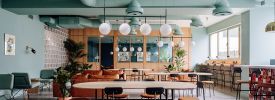
Reading time: 2 Minutes
As sustainably-built, low-waste flexible office spaces open in Barbados and Norway, we take a look at how Regus is making the office a greener place to be
As we emerge from the quiet skies and deserted streets of the Covid-19 pandemic, how businesses can continue and dial up greener business practices is a huge topic of conversation. But for Regus, collaborating with greener, more efficient, low-waste developments has been a priority for years.
Take Regus Trondheim, which opened in 2019 in the Norwegian city’s first ‘energy positive’ building, Powerhouse Brattørkaia. Energy positive developments go one step further than sustainable architecture, not simply using less energy, but creating more energy than they use. On average, Powerhouse Brattørkaia produces more than twice as much electricity as it consumes daily; it was designed with the objective to supply renewable energy to itself, neighbouring buildings, electric buses, cars and boats, all through a local microgrid.
Another poster child for the sustainable office generation is Regus One Welches, which opened in 2016 in the most energy-efficient commercial building in Barbados. One Welches was designed with a super-efficient, low-waste air conditioning system; the roof and car park of the building are covered by solar panels, and a curtain wall lets in the maximum natural light, reducing the energy used on lighting inside.
It’s also a trend that is inspiring a lot of creativity and innovation in the architecture world. “In most of my projects now, the customer wants to be greener in design and architecture,” says architect Kristine Aassved Storeide, who has worked on sustainable IWG workspaces in Oslo and Bergen. “Not just in the materials we use or what we put into the building, but also the flexibility and the elasticity of the project.”
“If we design the building to be as flexible as possible, it means that when the company or users need to expand, change function, or have fewer people in, we don’t have to tear down walls or renovate the ventilation, lighting and plumbing,” This flexibility around the technical aspects of the building, she explains, save both construction costs and emissions down the line, as workspaces become more adaptable and flexible to suit the people within.
Beyond innovations around constructions and interior design, Regus’ very provision of flexible workspace also enables a more sustainable way of working, empowering businesses to book and occupy only the amount of office space needed at any given time, and to scale up or down as required. Using local flexspace nearer their employees’ homes can also help businesses to take the single biggest step towards meeting their ESG goals – cutting the commute.
It’s an exciting time for innovations around new workplaces, says Storeide, as we enter a new era of eco-consciousness around the concept of the workplace. From flexibly-designed buildings to upcycled interiors, a fresh approach is “going to attract the younger generation that are coming into the job market,” she predicts. “They want to work in a place that has a visibly green profile.”
To read more about Regus’s commitments to a greener workplace, see the IWG annual report.
Regus has been at the forefront of the way we work since opening its first location in 1989. Find out how its workspace solutions could help you and your business today


